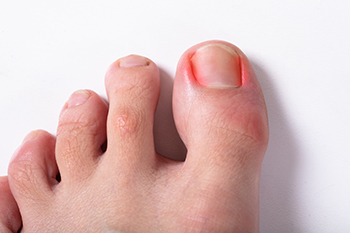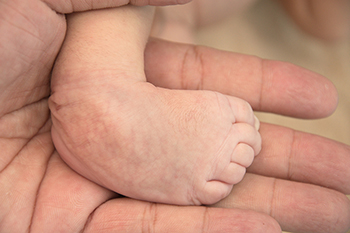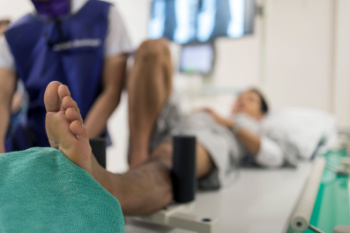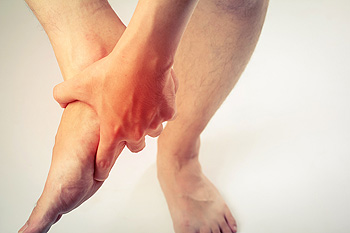July 2024
Painful Ingrown Toenails

Ingrown toenails occur when the edge of a toenail grows into the surrounding skin, instead of growing over it, causing pain, tenderness, redness, and swelling. This often occurs on the big toe. Preventing ingrown toenails involves cutting nails straight across and avoiding trimming them too short. Wearing proper-fitting shoes and socks can also reduce pressure on toes. Ingrown toenails can be very painful. If you suffer from persistent or infected ingrown toenails, it's suggested that you seek professional care from a podiatrist. They can safely trim or remove the ingrown portion of the nail, prescribe antibiotics if needed, and offer advice on preventing future occurrences. Prompt treatment from a podiatrist can prevent complications, such as infection or the need for more extensive procedures.
Ingrown toenails can become painful if they are not treated properly. For more information about ingrown toenails, contact one of our podiatrists of Advanced Foot & Ankle Associates, PLLC. Our doctors can provide the care you need to keep you pain-free and on your feet.
Ingrown Toenails
Ingrown toenails occur when a toenail grows sideways into the bed of the nail, causing pain, swelling, and possibly infection.
Causes
- Bacterial infections
- Improper nail cutting such as cutting it too short or not straight across
- Trauma to the toe, such as stubbing, which causes the nail to grow back irregularly
- Ill-fitting shoes that bunch the toes too close together
- Genetic predisposition
Prevention
Because ingrown toenails are not something found outside of shoe-wearing cultures, going barefoot as often as possible will decrease the likeliness of developing ingrown toenails. Wearing proper fitting shoes and using proper cutting techniques will also help decrease your risk of developing ingrown toenails.
Treatment
Ingrown toenails are a very treatable foot condition. In minor cases, soaking the affected area in salt or antibacterial soaps will not only help with the ingrown nail itself, but also help prevent any infections from occurring. In more severe cases, surgery is an option. In either case, speaking to your podiatrist about this condition will help you get a better understanding of specific treatment options that are right for you.
If you have any questions please feel free to contact one of our offices located in Lake Worth and Aledo/Willow Park, TX . We offer the newest diagnostic and treatment technologies for all your foot and ankle needs.
Symptoms and Causes of Clubfoot
 Clubfoot, medically known as congenital talipes equinovarus, is a condition where a baby is born with one or both feet turned inward and downward. Some cases are mild and others more severe. Symptoms include twisted or curved feet and underdeveloped calf muscles. While the exact cause of clubfoot is unknown, it may result from improper development of bones and ligaments in the womb. Clubfoot can be hereditary, affecting approximately one in 1,000 babies, more commonly boys. Diagnosis can occur via prenatal ultrasound or shortly after birth through a physical examination and sometimes an X-ray. Early treatment is essential for normal foot growth, with the Ponseti method being extremely effective. This involves gentle manipulation and casting of the feet over several weeks, followed by bracing to maintain correct positioning. In some cases, minor surgery may be needed to lengthen the Achilles tendon. If your baby is diagnosed with clubfoot, it is suggested that you schedule an appointment with a podiatrist for an exam, diagnosis, and treatment options.
Clubfoot, medically known as congenital talipes equinovarus, is a condition where a baby is born with one or both feet turned inward and downward. Some cases are mild and others more severe. Symptoms include twisted or curved feet and underdeveloped calf muscles. While the exact cause of clubfoot is unknown, it may result from improper development of bones and ligaments in the womb. Clubfoot can be hereditary, affecting approximately one in 1,000 babies, more commonly boys. Diagnosis can occur via prenatal ultrasound or shortly after birth through a physical examination and sometimes an X-ray. Early treatment is essential for normal foot growth, with the Ponseti method being extremely effective. This involves gentle manipulation and casting of the feet over several weeks, followed by bracing to maintain correct positioning. In some cases, minor surgery may be needed to lengthen the Achilles tendon. If your baby is diagnosed with clubfoot, it is suggested that you schedule an appointment with a podiatrist for an exam, diagnosis, and treatment options.
Congenital foot problems require immediate attention to avoid future complications. If you have any concerns, contact one of our podiatrists of Advanced Foot & Ankle Associates, PLLC. Our doctors can provide the care you need to keep you pain-free and on your feet.
Congenital foot problems are deformities affecting the feet, toes, and/or ankles that children are born with. Some of these conditions have a genetic cause while others just happen. Some specific foot ailments that children may be born with include clubfeet, polydactyly/macrodactyly, and cleft foot. There are several other foot anomalies that can occur congenitally. What all of these conditions have in common is that a child may experience difficulty walking or performing everyday activities, as well as trouble finding footwear that fits their foot deformity. Some of these conditions are more serious than others. Consulting with a podiatrist as early as possible will help in properly diagnosing a child’s foot condition while getting the necessary treatment underway.
What are Causes of Congenital Foot Problem?
A congenital foot problem is one that happens to a child at birth. These conditions can be caused by a genetic predisposition, developmental or positional abnormalities during gestation, or with no known cause.
What are Symptoms of Congenital Foot Problems?
Symptoms vary by the congenital condition. Symptoms may consist of the following:
- Clubfoot, where tendons are shortened, bones are shaped differently, and the Achilles tendon is tight, causing the foot to point in and down. It is also possible for the soles of the feet to face each other.
- Polydactyly, which usually consists of a nubbin or small lump of tissue without a bone, a toe that is partially formed but has no joints, or an extra toe.
- Vertical talus, where the talus bone forms in the wrong position causing other bones in the foot to line up improperly, the front of the foot to point up, and the bottom of the foot to stiffen, with no arch, and to curve out.
- Tarsal coalition, when there is an abnormal connection of two or more bones in the foot leading to severe, rigid flatfoot.
- Cleft foot, where there are missing toes, a V-shaped cleft, and other anatomical differences.
- Macrodactyly, when the toes are abnormally large due to overgrowth of the underlying bone or soft tissue.
Treatment and Prevention
While there is nothing one can do to prevent congenital foot problems, raising awareness and receiving neonatal screenings are important. Early detection by taking your child to a podiatrist leads to the best outcome possible.
If you have any questions please feel free to contact one of our offices located in Lake Worth and Aledo/Willow Park, TX . We offer the newest diagnostic tools and technology to treat your foot and ankle needs.
Tips for Finding Shoes That Fit Properly

Surprisingly, about 70 percent of people wear shoes that don’t fit well, leading to discomfort and potential long-term issues affecting the feet and ankles, as well as other body parts. To ensure a proper fit, start by measuring your feet, as sizes can vary between brands and your feet change over time. Shop in the afternoon when your feet are slightly swollen, ensuring a fit that accommodates daily activity. Look for shoes with adequate support and structure, avoiding overly soft footwear that lacks stability. Check for a thumb’s width of space at the toe and consider the shape of the shoe to avoid cramped toes. Heels higher than 1.5 inches can worsen foot problems. For those on carpets or with mobility issues, lightweight polyurethane soles are a better option than heavy rubber. Breathable materials and appropriate socks are also important to prevent moisture buildup and subsequent issues, like corns or blisters. Special features can accommodate specific conditions like diabetes, bunions, or hammertoe. For personalized advice and to address any foot-related concerns, it is suggested that you make an appointment with a podiatrist.
Finding a properly-fitting shoe is important in reducing injuries and preventing foot problems. For more information about treatment, contact one of our podiatrists from Advanced Foot & Ankle Associates, PLLC. Our doctors will treat your foot and ankle needs.
Proper Shoe Fitting
A common concern when it comes to foot health, having properly fitted shoes can help prevent injuries to the foot. Out feet affect our posture and gait, which in turn affects the biomechanics and overall bodily structure. With 33 joints, 26 bones, and over 100 ligaments, the potential for serious injury is much greater than one realizes. Although the feet cease growth in adulthood, they still change shape as they mature. Here are some factors to consider when it comes to investing in proper fitting shoes:
- Be sure the shoes fit correctly right away
- Ensure the ball of your foot fits comfortably in the widest portion of the shoes
- Even though they may look fashionable, improper fitting shoes can either create adverse conditions or exacerbate existing ones you may already have
- Walk along a carpeted surface to ensure the shoes comfortably fit during normal activity
Keeping in mind how shoes fit the biomechanics of your body, properly-fitting shoes are vitally important. Fortunately, it is not difficult to acquire footwear that fits correctly. Be sure to wear shoes that support the overall structure of your body. Do your feet a favor and invest in several pairs of well-fitted shoes today.
If you have any questions please feel free to contact one of our offices located in Lake Worth and Aledo/Willow Park, TX . We offer the newest diagnostic and treatment technologies for all your foot and ankle needs.
Do Your Child's Feet Hurt?
Key Facts About Foot Stress Fractures
 Foot stress fractures are tiny cracks, usually found in the long bones of the foot, that result from repetitive force or overuse. These fractures often occur in athletes and individuals who engage in high-impact activities like running or jumping. Risk factors can include a sudden increase in activity intensity, wearing improper footwear, and conditions like osteoporosis that weaken bones. Stress fractures develop when muscles become fatigued and lose their ability to absorb shock, transferring the impact to the bones. Common sites for these fractures are the metatarsal bones, which bear significant weight during movement. Symptoms often include pain, swelling, and tenderness that worsen with activity. Early diagnosis is vital for healing and preventing further complications. If you have foot pain after bouts of exercise, it is suggested that you contact a podiatrist who can accurately diagnose and treat stress fractures.
Foot stress fractures are tiny cracks, usually found in the long bones of the foot, that result from repetitive force or overuse. These fractures often occur in athletes and individuals who engage in high-impact activities like running or jumping. Risk factors can include a sudden increase in activity intensity, wearing improper footwear, and conditions like osteoporosis that weaken bones. Stress fractures develop when muscles become fatigued and lose their ability to absorb shock, transferring the impact to the bones. Common sites for these fractures are the metatarsal bones, which bear significant weight during movement. Symptoms often include pain, swelling, and tenderness that worsen with activity. Early diagnosis is vital for healing and preventing further complications. If you have foot pain after bouts of exercise, it is suggested that you contact a podiatrist who can accurately diagnose and treat stress fractures.
Activities where too much pressure is put on the feet can cause stress fractures. To learn more, contact one of our podiatrists from Advanced Foot & Ankle Associates, PLLC. Our doctors can provide the care you need to keep your pain free and on your feet.
Dealing with Stress Fractures of the Foot and Ankle
Stress fractures occur in the foot and ankle when muscles in these areas weaken from too much or too little use. The feet and ankles then lose support when walking or running from the impact of the ground. Since there is no protection, the bones receive the full impact of each step. Stress on the feet can cause cracks to form in the bones, thus creating stress fractures.
What Are Stress Fractures?
Stress fractures occur frequently in individuals whose daily activities cause great impact on the feet and ankles. Stress factors are most common among:
- Runners
- People affected with Osteoporosis
- Tennis or basketball players
- Gymnasts
- High impact workouts
Symptoms
Pain from the fractures occur in the area of the fractures and can be constant or intermittent. It will often cause sharp or dull pain with swelling and tenderness. Engaging in any kind of activity which involves high impact will aggravate pain.
If you have any questions please feel free to contact one of our offices located in Lake Worth and Aledo/Willow Park, TX . We offer the newest diagnostic and treatment technologies for all your foot and ankle needs.
The Pain of Plantar Fasciitis
 Plantar fasciitis is a common foot condition characterized by inflammation of the plantar fascia, a thick band of tissue that runs along the bottom of the foot, connecting the heel bone to the toes. It occurs when this tissue is overstretched or overused, often due to excessive running, standing for long periods, or wearing inadequate footwear. The condition manifests as a sharp, stabbing pain in the heel, particularly noticeable with the first steps in the morning or after long periods of inactivity. Those at higher risk include runners, individuals with high arches or flat feet, people who are overweight, and people who wear shoes with poor arch support. Preventing plantar fasciitis involves wearing supportive footwear, maintaining a healthy weight, and incorporating stretching exercises into daily routines to improve flexibility. Treatment options include rest and stretching exercises, For persistent pain, custom orthotics may be necessary. If you have continued heel pain, it is suggested that you schedule an appointment with a podiatrist for a proper diagnosis and treatment.
Plantar fasciitis is a common foot condition characterized by inflammation of the plantar fascia, a thick band of tissue that runs along the bottom of the foot, connecting the heel bone to the toes. It occurs when this tissue is overstretched or overused, often due to excessive running, standing for long periods, or wearing inadequate footwear. The condition manifests as a sharp, stabbing pain in the heel, particularly noticeable with the first steps in the morning or after long periods of inactivity. Those at higher risk include runners, individuals with high arches or flat feet, people who are overweight, and people who wear shoes with poor arch support. Preventing plantar fasciitis involves wearing supportive footwear, maintaining a healthy weight, and incorporating stretching exercises into daily routines to improve flexibility. Treatment options include rest and stretching exercises, For persistent pain, custom orthotics may be necessary. If you have continued heel pain, it is suggested that you schedule an appointment with a podiatrist for a proper diagnosis and treatment.
Plantar fasciitis can be very painful and inconvenient. If you are experiencing heel pain or symptoms of plantar fasciitis, contact one of our podiatrists from Advanced Foot & Ankle Associates, PLLC. Our doctors can provide the care you need to keep you pain-free and on your feet.
What Is Plantar Fasciitis?
Plantar fasciitis is the inflammation of the thick band of tissue that runs along the bottom of your foot, known as the plantar fascia, and causes mild to severe heel pain.
What Causes Plantar Fasciitis?
- Excessive running
- Non-supportive shoes
- Overpronation
- Repeated stretching and tearing of the plantar fascia
How Can It Be Treated?
- Conservative measures – anti-inflammatories, ice packs, stretching exercises, physical therapy, orthotic devices
- Shockwave therapy – sound waves are sent to the affected area to facilitate healing and are usually used for chronic cases of plantar fasciitis
- Surgery – usually only used as a last resort when all else fails. The plantar fascia can be surgically detached from the heel
While very treatable, plantar fasciitis is definitely not something that should be ignored. Especially in severe cases, speaking to your doctor right away is highly recommended to avoid complications and severe heel pain. Your podiatrist can work with you to provide the appropriate treatment options tailored to your condition.
If you have any questions please feel free to contact one of our offices located in Lake Worth and Aledo/Willow Park, TX . We offer the newest diagnostic and treatment technologies for all your foot and ankle needs.
Blog Archives
- April 2025
- March 2025
- February 2025
- January 2025
- December 2024
- November 2024
- October 2024
- September 2024
- August 2024
- July 2024
- June 2024
- May 2024
- April 2024
- March 2024
- February 2024
- January 2024
- December 2023
- November 2023
- October 2023
- September 2023
- August 2023
- July 2023
- June 2023
- May 2023
- April 2023
- March 2023
- February 2023
- January 2023
- December 2022
- November 2022
- October 2022
- September 2022
- August 2022
- July 2022
- June 2022
- May 2022
- April 2022
- March 2022
- February 2022
- January 2022
- December 2021
- November 2021
- October 2021
- September 2021
- August 2021
- July 2021
- June 2021
- May 2021
- April 2021
- March 2021
- February 2021
- January 2021
- December 2020
- November 2020
- October 2020
- September 2020
- August 2020
- July 2020
- June 2020
- May 2020
- April 2020
- March 2020
- February 2020
- January 2020
- December 2019
- November 2019
- October 2019
- September 2019
- August 2019
- July 2019
- June 2019
- May 2019
- April 2019
- March 2019
- February 2019
- January 2019
- December 2018
- November 2018
- October 2018





